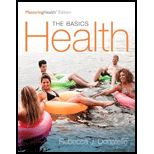
Health: The Basics, The Mastering Health Edition (12th Edition)
12th Edition
ISBN: 9780134183268
Author: Rebecca J. Donatelle
Publisher: PEARSON
expand_more
expand_more
format_list_bulleted
Question
Chapter 10, Problem 1PQ
Summary Introduction
To identify: The false statements associated with overweight or obesity
Introduction:
Obesity is a weight of the body, which is more than 20% above suggested levels or BMI (body mass index). BMI is a description of weight of the body relative to height of the body.
Overweight is a body weight, which is greater than 10% above healthy levels (BMI between 25 and 29). Overweight is considered as a weight above desirable or normal.
Expert Solution & Answer
Want to see the full answer?
Check out a sample textbook solution
Chapter 10 Solutions
Health: The Basics, The Mastering Health Edition (12th Edition)
Ch. 10 - Prob. 1WDYTCh. 10 - Prob. 2WDYTCh. 10 - What actions could you take to combat these...Ch. 10 - Prob. 4WDYTCh. 10 - Prob. 5WDYTCh. 10 - Prob. 6WDYTCh. 10 - Prob. 7WDYTCh. 10 - Prob. 8WDYTCh. 10 - Prob. 9WDYTCh. 10 - Prob. 1WDYS
Ch. 10 - Prob. 2WDYSCh. 10 - Prob. 1PQCh. 10 - Prob. 2PQCh. 10 - Prob. 3PQCh. 10 - Prob. 4PQCh. 10 - Prob. 5PQCh. 10 - Prob. 6PQCh. 10 - Prob. 7PQCh. 10 - Prob. 8PQCh. 10 - Prob. 9PQCh. 10 - Prob. 10PQCh. 10 - Prob. 1TAICh. 10 - Prob. 2TAICh. 10 - Prob. 3TAICh. 10 - Prob. 4TAICh. 10 - Prob. 1PQACh. 10 - Prob. 2PQACh. 10 - Prob. 3PQA
Knowledge Booster
Similar questions
- The word DETERMINE is an acronym used in assessing an elderly person's.. a. risk of malnutrition b. bone integrity c. degree of independence d. all of the abovearrow_forwardWhich two minerals are the major constituents of bone? a. calcium and zinc b. sodium and magnesium c. phosphorus and calcium d. magnesium and calciumarrow_forwardWithout proper management, type 1 or type 2 diabetes during pregnancy can cause all except a. severe nausea. b. severe hypoglycemia or hyperglycemia. c. preterm labor. d. pregnancy-related hypertension.arrow_forward
arrow_back_ios
arrow_forward_ios
Recommended textbooks for you
- Lifetime Physical Fitness & WellnessHealth & NutritionISBN:9781337677509Author:HOEGERPublisher:Cengage
 Nutrition: Concepts and Controversies - Standalo...Health & NutritionISBN:9781305627994Author:Frances Sizer, Ellie WhitneyPublisher:Brooks Cole
Nutrition: Concepts and Controversies - Standalo...Health & NutritionISBN:9781305627994Author:Frances Sizer, Ellie WhitneyPublisher:Brooks Cole NutritionHealth & NutritionISBN:9781337906371Author:Sizer, Frances Sienkiewicz., WHITNEY, ElliePublisher:Cengage Learning,
NutritionHealth & NutritionISBN:9781337906371Author:Sizer, Frances Sienkiewicz., WHITNEY, ElliePublisher:Cengage Learning,  Nutrition Through The Life CycleHealth & NutritionISBN:9781337919333Author:Brown, Judith E.Publisher:Cengage Learning,
Nutrition Through The Life CycleHealth & NutritionISBN:9781337919333Author:Brown, Judith E.Publisher:Cengage Learning,

Lifetime Physical Fitness & Wellness
Health & Nutrition
ISBN:9781337677509
Author:HOEGER
Publisher:Cengage

Nutrition: Concepts and Controversies - Standalo...
Health & Nutrition
ISBN:9781305627994
Author:Frances Sizer, Ellie Whitney
Publisher:Brooks Cole

Nutrition
Health & Nutrition
ISBN:9781337906371
Author:Sizer, Frances Sienkiewicz., WHITNEY, Ellie
Publisher:Cengage Learning,



Nutrition Through The Life Cycle
Health & Nutrition
ISBN:9781337919333
Author:Brown, Judith E.
Publisher:Cengage Learning,